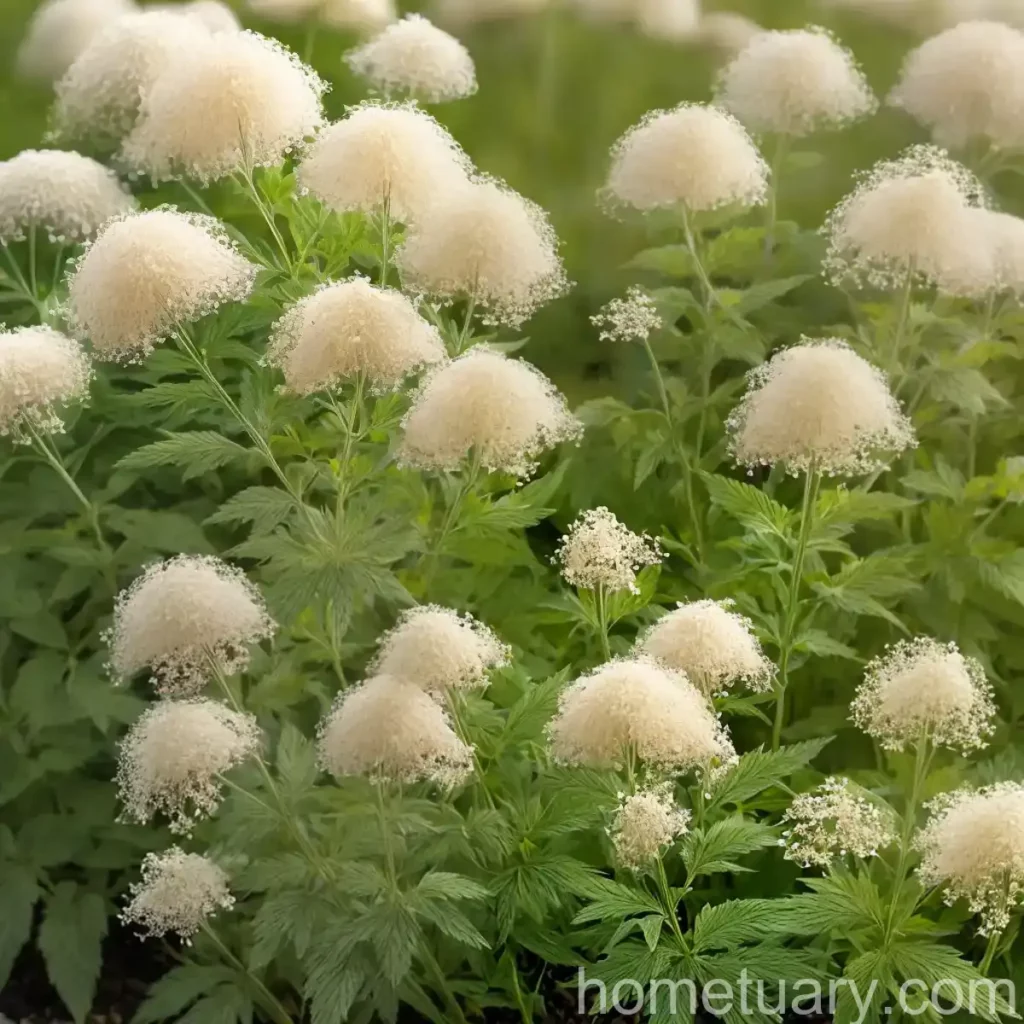Plant Profile: Meadowsweet (Filipendula purpurea ‘Elegans’)
Meadowsweet (Filipendula purpurea ‘Elegans’) is a stunning perennial plant that has gained popularity among gardeners for its beautiful, feathery blossoms and ease of care. This plant belongs to the Rosaceae family and is native to the meadows and damp woodlands of Europe and Western Asia. It is a herbaceous plant that typically blooms in the summer, adding lovely color and texture to gardens.
What is Meadowsweet (Filipendula purpurea ‘Elegans’)?
Meadowsweet, scientifically known as Filipendula purpurea ‘Elegans,’ is a visually captivating plant that features large, fluffy, pink flowers, and attractive, deeply lobed foliage. This cultivar is renowned for its elegant appearance and its ability to thrive in a variety of growing conditions. The common name “meadowsweet” is fitting, as this plant naturally grows in meadow-like settings and brings a delightful, soft charm to any garden.
Key Takeaways – Meadowsweet (Filipendula purpurea ‘Elegans’)
Before digging into the specific care requirements for meadowsweet, it’s helpful to understand the key takeaways regarding this delightful plant:
- Bright pink flowers with feathery plumes
- Native to Europe and Western Asia
- Adaptable and easy to grow
- Attracts pollinators like bees and butterflies
- Provides medicinal benefits and has culinary uses
Now that we have covered the basics, let’s delve into the essential aspects of caring for Meadowsweet (Filipendula purpurea ‘Elegans’).
Cultivation of Meadowsweet
When considering the cultivation of Meadowsweet, it is important to address the specific growing requirements in terms of water, sunlight, soil, and fertilization. These factors play a vital role in the overall health and vigor of the plant.
Water
Meadowsweet thrives in consistently moist soil and prefers to be kept evenly moist. It is important to monitor the soil moisture, especially during periods of hot, dry weather. Regular watering is essential, particularly in the absence of natural rainfall. Applying a layer of organic mulch around the base of the plant can help retain moisture and suppress weed growth.
Sunlight
In terms of sunlight, Meadowsweet prefers partial shade to full sun. It can tolerate some dappled shade, especially in regions with hot summers. Providing adequate sunlight is crucial for promoting healthy growth and abundant flowering.
Soil
Meadowsweet thrives in rich, well-draining soil with a slightly acidic to neutral pH. Incorporating organic matter, such as compost or well-rotted manure, into the planting area can enhance soil fertility and structure, ensuring an optimal growing environment for the plant.
Fertilizer
A balanced, slow-release fertilizer can be applied in early spring to support the plant’s growth and flowering. It is important to follow the recommended application rates specified on the fertilizer packaging to avoid over-fertilization, which can be detrimental to the plant.
Pruning Meadowsweet
Pruning is an essential aspect of Meadowsweet maintenance. This process helps to shape the plant, remove spent flowers, and promote a tidy appearance. Deadheading, which involves the removal of faded flowers, encourages the plant to redirect its energy into new growth and potential reblooming.
Propagation
Meadowsweet can be propagated by division in early spring or fall. When dividing the plant, it is important to ensure that each division has a viable portion of the root system and several growing shoots. Divisions can then be replanted in suitable locations with the appropriate growing conditions.
Common Diseases and Pests
Common Diseases
Meadowsweet is generally resistant to many diseases, but it is susceptible to certain fungal infections under conditions of poor air circulation and excessive moisture. Powdery mildew and rust are among the potential diseases that can affect Meadowsweet. To mitigate these risks, it is important to provide adequate spacing between plants, promote good air circulation, and avoid overwatering.
Common Pests
Although Meadowsweet is relatively resistant to pests, it may occasionally be targeted by aphids, which can be addressed through organic pest control methods such as insecticidal soap or horticultural oil. Regular monitoring of the plant can help detect pest infestations early and prevent significant damage.
Container Gardening with Meadowsweet
Meadowsweet can also thrive in containers, making it a versatile option for gardeners with limited space or for those who wish to bring its beauty to specific areas of the garden. When growing Meadowsweet in containers, it is essential to choose a sizable container with adequate drainage holes to prevent waterlogging.
Soil for Containers
A well-draining potting mix formulated for perennial plants is ideal for container-grown Meadowsweet. This type of soil provides the necessary support and nutrition for the plant while ensuring proper drainage.
Sunlight for Container-Grown Meadowsweet
When cultivating Meadowsweet in containers, it is advisable to position the pots in a location that receives partial shade, especially in regions with intense summer heat. Providing the right balance of sunlight is crucial for the plant’s overall health and growth.
Uses of Meadowsweet (Filipendula purpurea ‘Elegans’)
Meadowsweet has multifaceted uses in the garden and beyond. From its ornamental appeal to its practical applications, this plant offers a range of benefits and possibilities.
Ornamental Uses
Meadowsweet serves as a beautiful, ornamental addition to gardens, borders, and naturalistic landscapes. Its striking floral display, coupled with its graceful foliage, adds an enchanting element to various settings. Whether cultivated in mixed perennial borders or as a standalone feature, Meadowsweet contributes a captivating presence.
Medicinal and Culinary Uses
Aside from its ornamental value, Meadowsweet also possesses medicinal properties and has been historically used in herbal medicine. The plant contains compounds with anti-inflammatory and pain-relieving properties, making it a valuable ingredient in herbal remedies. Additionally, the flowers of Meadowsweet can be used to make fragrant teas and infusions, adding a delightful and aromatic touch to beverages.
Fun Facts about Meadowsweet
- Meadowsweet has a rich history of traditional use, often being included in ancient rituals and ceremonies.
- The sweet-scented flowers of Meadowsweet were a favored strewing herb in medieval times, used to add a pleasant fragrance to indoor spaces.
- The plant’s name, Meadowsweet, is derived from its traditional use as a strewing herb in meadows and homes, where it imparted a sweet scent.
Botanist’s Tips
- Maintaining consistent soil moisture is key to promoting healthy growth and flowering in Meadowsweet.
- Regular deadheading can encourage the plant to produce additional blooms, prolonging the flowering period and enhancing its visual appeal.
- Monitoring the plant for signs of pests or diseases and taking prompt action can help maintain its overall vigor and appearance.
Links to External Resources
For further information on Meadowsweet and related topics, explore the following resources:
- Royal Horticultural Society – Filipendula purpurea ‘Elegans’
- Missouri Botanical Garden – Filipendula purpurea ‘Elegans’
- University of Wisconsin-Madison Extension – Meadowsweet
- The Spruce – Growing Meadowsweet
In conclusion, Meadowsweet (Filipendula purpurea ‘Elegans’) is a captivating and versatile plant with a wide range of uses in the garden. Its beautiful flowers, adaptability, and historical significance make it a valuable addition to any landscape. By understanding and implementing the appropriate care guidelines, gardeners can enjoy the beauty and benefits of Meadowsweet while ensuring its long-term health and vitality. Whether grown for its ornamental value, medicinal properties, or culinary uses, Meadowsweet stands as a beloved and cherished plant with much to offer.















